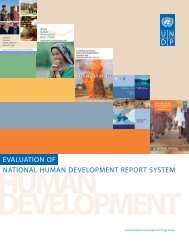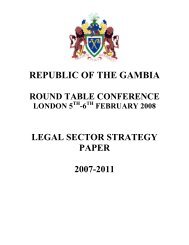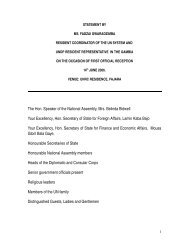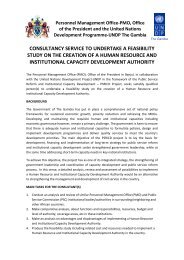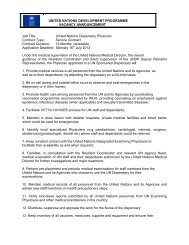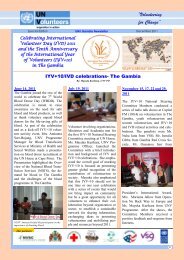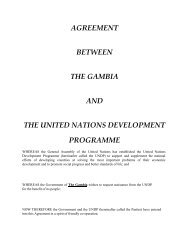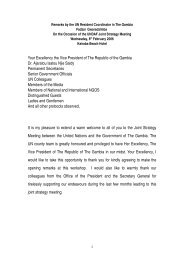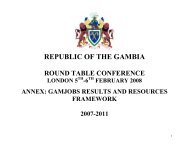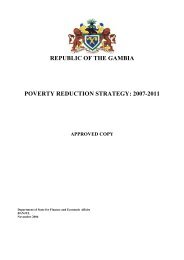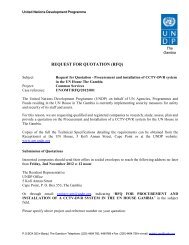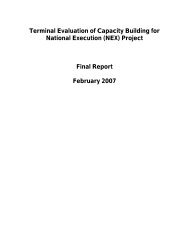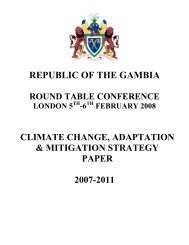Introduction - UNDP The Gambia
Introduction - UNDP The Gambia
Introduction - UNDP The Gambia
Create successful ePaper yourself
Turn your PDF publications into a flip-book with our unique Google optimized e-Paper software.
________________________________________________________________________________________________________________________<br />
necessary support and to strengthen them<br />
through a process of decentralisation. This<br />
requires the involvement of the local<br />
communities from the start of policy planning<br />
at the local level to ensure the development of<br />
an effective delivery system that is supported<br />
by the local population.<br />
In Africa, traditional structures have been<br />
used effectively to bargain for development,<br />
such as the Council of Chiefs in Ghana and<br />
the emirate and caliphate in northern Nigeria.<br />
In <strong>The</strong> <strong>Gambia</strong>, similar traditional structures<br />
exist, which form the basis of the country’s<br />
traditional systems.<br />
Several studies have shown that African<br />
social and material development is influenced<br />
by a complex composition of groupings,<br />
associations and structures that have evolved<br />
from time immemorial in response to<br />
changing circumstances. <strong>The</strong>se structures<br />
have served various interests, have been<br />
utilised in many ways and have altered<br />
substantially over time.<br />
<strong>The</strong> structures have consistently formed the<br />
normal framework on which both colonial<br />
and post-colonial development policies and<br />
politics have relied to achieve their<br />
development aims and objectives. <strong>The</strong>y also<br />
serve as the entry point for the social,<br />
political and economic communication of<br />
social interactions, thus forming the cultural,<br />
social and material context.<br />
During the colonial period, the colonial<br />
masters in most parts of the continent viewed<br />
such groups as conduits and opportunities to<br />
enhance their colonial policy. <strong>The</strong>se<br />
traditional structures facilitated control, hence<br />
the persistence of existing social structures<br />
and traditional political systems, which play<br />
crucial roles in current development<br />
initiatives in Africa. In most cases, these<br />
frameworks were allowed to maintain their<br />
separate identity as in the past but were<br />
incorporated simultaneously into the colonial<br />
structures.<br />
<strong>The</strong> colonialists did not have to reinvent the<br />
wheel to entrench their policies, but rather<br />
worked closely with the existing structures by<br />
enhancing their capacity to suit their<br />
objectives. Through this process, the British<br />
used the Indirect Rule principle to access<br />
those that would facilitate the process for<br />
them. Similarly, the French principle of<br />
assimilation was based on their objectives.<br />
5.1.2 <strong>Gambia</strong>n Traditional Structures<br />
Generally, <strong>Gambia</strong>n traditional structures<br />
have their roots in the country’s traditional<br />
forms of social organisations and groupings,<br />
with development initiatives conducted<br />
through a complex web of social and<br />
institutional settings, and interpersonal<br />
relationships.<br />
Traditionally, the political set-ups are based<br />
on founding families who were considered<br />
king-makers. Succession was based on<br />
seniority and concession among the elders in<br />
a particular district comprising a number of<br />
villages ruled by a chief with each village<br />
headed by an alkalo.<br />
<strong>The</strong> traditional structures at the<br />
community/municipal levels have always<br />
been development partners of the<br />
government. It is the state that provides the<br />
context for official interactions (of traditional<br />
authorities) in the public domain. <strong>The</strong><br />
structures constitute the fundamental building<br />
blocks of the interchanges and actions to<br />
fulfil development; they have been reshaped<br />
or new ones formed.<br />
Through these structures various interests<br />
obtain access to resources and enhance<br />
cultural and social meaning. Among them are<br />
the Council of Elders, the chieftaincy,<br />
alkaloship, imamship, kabilo (clan<br />
organisations), kafoo and gendered groups,<br />
which exist in almost all <strong>Gambia</strong>n<br />
communities.<br />
<strong>The</strong> Kabilo Systems: <strong>Gambia</strong>n kingdoms<br />
were ruled by a single lineage or kabilo<br />
(Sonko-Godwin, 1994). Thus settlements in<br />
<strong>The</strong> <strong>Gambia</strong> are divided into wards:<br />
kabilo/kabiloolu in Mandinka, sare or sinchu<br />
in Fula, sancha in Wolof etc, each of which<br />
traces its origins to a particular lineage or<br />
________________________________________________________________________________________________<br />
Building Capacity for the Attainment of the Millennium Development Goals in <strong>The</strong> <strong>Gambia</strong> National Human Development Report 2005<br />
51




